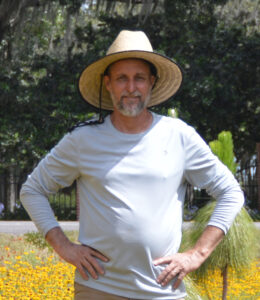 Troy Springer’s love of native plants has fueled his landscape company’s growth. Smart use of Hitachi rentals helped him do more.
Troy Springer’s love of native plants has fueled his landscape company’s growth. Smart use of Hitachi rentals helped him do more.
Landscaping and a love of native plants came to Troy Springer naturally. “I’ve always been interested in wildlife and nature,” says the Tampa, Florida-area native.
Early on, Springer worked for a traditional landscaping company, but like many successful people, he quickly realized he needed to carve his own path to be satisfied.
“I almost got out of landscaping because I felt like what I was doing for other companies was harmful,” Springer says. In particular, he disliked the practice of many traditional landscapers who use plants that may be appealing visually but aren’t native to the area where they are planted. Non-native plants can do one of two things, he says: they can become invasive, or they can fail.
“Then I discovered the native plant societies and got involved,” Springer says. “I studied relentlessly, and I started practicing it, and I got better and better at it. Now I have a pretty good reputation.”
That reputation includes serving as a former chapter president of the Florida Native Plant Society and producing a conference for them. Springer is also the secretary and on the board of the Florida Association of Native Nurseries, the nation’s largest professional native plant network.
Design-build
Today, Springer Environmental has eight employees, working as three different crews. The company’s work is primarily design-build for high-end residential landscaping customers, but they also do some commercial work, such as the landscaping for a new City of Tampa park.
“They needed a native plant specialist, and I was the only game in town,” Springer says. “I have done work with some developers, but I’m more of a custom-build guy because I design my own landscapes. I typically target homeowners directly.”
Springer’s shop sits on a few acres that he is developing into a nursery, where he can demonstrate to customers the beauty and variety of native plants. “Retail is a good fit for bringing in potential customers,” he says. “They can come in and see the plants and some of the work we do.”
Big machine for small company
Springer owns a handful of small tractors used to carry plants in containers and move soil and other materials. But as the size and scope of the landscapes he created increased, Springer knew he would need a bigger machine.
Smaller machines didn’t have the horse power or the weight and balance to carry sable palms and pines ranging anywhere from 15 to 30 feet tall. Some weigh more than a ton. Backhoes and skid steers were too hard on turf, and even compact track loaders didn’t have the weight to counterbalance these big trees.
And planting these trees involves more than just dropping them in a hole. With their long trunks, these trees must be positioned with the trunk perfectly vertical from all angles. The tree is often initially placed and then picked up and repositioned multiple times as Springer and his crewmembers evaluate the line of the trunk. If necessary, the hole may be dug a little deeper or more to one side to get a perfectly plumb tree.
But the company didn’t have the cash flow to support the purchase of a bigger machine. The solution was to rent Hitachi ZW50 and ZW80 wheel load-ers when the job requires it, which is typically several times a year. Springer outfits his rental units with a tree boom, and with the articulating front end of the wheel loader, he can carry and fine tune the placement of the tree with minimal movement of the machine and minimal disturbance of the turf.
Racing connections
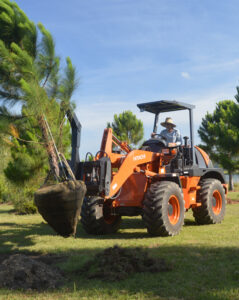 Steve Tuton, salesman for Great Southern Equipment, first met Springer thanks to a shared hobby: racing Mazda Miata sports cars.
Steve Tuton, salesman for Great Southern Equipment, first met Springer thanks to a shared hobby: racing Mazda Miata sports cars.
“I quickly determined his business overlapped with mine and that he could be an occasional user of some of our equipment,” Tuton says.
“Kawasaki didn’t have the small loaders back then, but when the Hitachi loaders became available, I made sure he knew about them.”
The relationship turned out to be mutually beneficial. “Troy introduced me to many other members of our native plant societies, including owners of tree nurseries and landscape tree installers,” Tuton says. As a result, Great Southern Equipment started exhibiting in the local shows for these landscapers and tree growers, he says.
Great Southern Equipment doesn’t do a lot of short-term rentals, but when the machines are available and the customer is known to take care of the equipment, Tuton says they are happy to help. Business owners like Springer will often arrange their schedules so they can do multiple jobs in consecutive days and rent the machine for a whole week to get the most out of it, he says.
“None of the small operators are unimportant to us,” Tuton says. “They all matter. Many companies that were smaller when I started 20 years ago are good-sized companies now. If you spend the time to understand their needs and take care of them, they will keep doing business with you as they grow.”
The old Florida look
Springer’s passion for landscaping and native plants is infectious. “I struggled with this business for years because I had this dream of doing something really good for this state, but we’re just now starting to make an impact,” he says. “Ten or 15 years ago, people thought I was crazy to be planting pine trees and palmettos and putting wildflowers in your yard. But they don’t think it’s crazy anymore. It’s amazing how it has exploded in popularity. Our sales have grown significantly.” A recent photo posted on the company’s Facebook page got nearly 1,750 likes, he says.
Springer’s goal is more than just nice-looking yards and landscapes. As Florida’s population continues to boom, residents have become conscious of its unique heritage and culture. Newcomers and old timers alike have rediscovered what Springer calls the “old Florida,” one of lush gardens and crystal-clear springs. But with more people, environmental pressures increase. Native plants not only help achieve the old Florida look, but maintain it by being the right environmental choice, too.
In a climate with a year-round growing season, invasive and non-native plants can run rampant, choking out native plants, clogging waterways and wreaking havoc on what should be a well-balanced and sustainable ecosystem. Native plants are not only better adapted to the climate, but they provide forage and sustenance for everything from birds and butterflies to the Florida black bear as well.
“In Florida there are so many people coming here, we try to be mindful of quality construction and quality landscaping,” Springer says. “If you can make money improving the quality of the environment, that is a major step in having a higher quality society. It’s just good business.”
This story first appears in Hitachi’s Fall 2021 issue of FOCUS magazine. Download the magazine here.
Using everything from greenhouses and garden shears to a pair of six-ton loaders with massive Hitachi machinery attachments, this company in central Florida grows landscaping trees big and small.
As a helper in his father’s vegetable farm, Stoney Maddox has had his hands in the soil growing plants since as far back as he can remember.
In 1999 he acquired nine acres and started a tree farm business in Bevilles Corner, Florida.
From those humble beginnings, he’s grown his business to encompass more than 100 acres.
Taylor-Cade Trees (named after his children) nurtures trees from the seeds in a greenhouse up to mature specimens planted in the ground and harvested after five years. Selling to nurseries and frontline landscapers, the company offers everything from containerized trees and shrubs to ground-planted trees upward of 10 to 20 feet tall. Live oaks are his most popular product, but he sells plenty of magnolias and evergreens as well.
With large greenhouses and planted trees stretching to the horizon, Maddox is a busy man. “We have 34 employees and planting goes on year-round,” he says. As a wholesale distributor the company sells north of 300,000 trees a year. Taylor-Cade Trees is family owned and operated. Maddox’s wife, Lori, does the company payroll while he mostly takes care of the work in the fields and greenhouses.
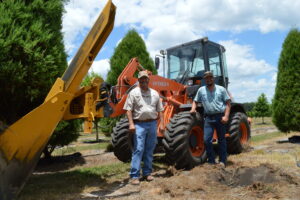 Maddox’s employees plant seedlings and containers six days a week, sometimes seven. Planting and harvesting the more mature trees with Hitachi machinery attachments usually takes place in the winter when there is less stress on the trees. But there’s no real off season.
Maddox’s employees plant seedlings and containers six days a week, sometimes seven. Planting and harvesting the more mature trees with Hitachi machinery attachments usually takes place in the winter when there is less stress on the trees. But there’s no real off season.
While in the containers the trees grow 6 to 10 feet tall. To keep these container-bound trees from blowing over in a storm, they’re lashed to a long line of cable. But when hurricanes threaten, it’s all hands-on deck as crews scramble to untie the cables and lay these hundreds of valuable and vulnerable trees on the ground.
Maddox says he occasionally forces himself to take a few days off to go fishing or hunting, but even then, in the back of his mind, he says he’s always thinking about his trees.
Starting with seed
In the Taylor-Cade greenhouses, thousands of seeds growing in trays must be maintained at precise temperatures and moisture levels around the clock until they’re ready to transfer into containers. Depending on the species, the temperature, moisture, and soil medium in which they’re growing vary by subtle amounts. There’s a lot of science to it, but Maddox is beyond science. After all these years, he’s turned it into an art.
From starting the seedlings to pruning, there is a huge amount of hand work that goes into a tree farm like Taylor-Cade. But with more than 100 acres in play they need machinery as well. The company’s fleet consists of an aerial lift, trucks, sprayers and a dozen or so utility tractors.
That’s enough to keep mechanic Brett Anderson busy year-round. But the workhorses and newest machines in his fleet are two recently acquired Hitachi ZW80 wheel loaders, both with Hitachi machinery attachments that see about 500 hours a year.
Stoney chose the Hitachis in large part because for years he had run the precursor to the Hitachi ZW80, the TCM loader. “Except for our old TCM, we’ve never had anything other than the Hitachis. They’re bullet proof,” Maddox says. Taylor-Cade operators run the loaders to clean up, build burn piles and move pallets. But the most critical application performed by the ZW80s is powering a tree spade to dig up the mature trees and load them onto trucks.
Valuable commodities
Once the containerized trees are planted in the ground and begin growing, crews work through the rows and carefully prune them several times a season to make sure the leaves or needles get a full measure of sunshine, and the trunks grow as straight as possible. As you might imagine with all the time and work that goes into them, these planted trees are Taylor-Cade’s most valuable commodities.
Live oaks are even more in demand this year. After winter ice and single-digit temperatures killed vast numbers of trees in Texas, the call for trees heading west has been unprecedented, Maddox says.
 Reaping the reward
Reaping the reward
After three to five years in the ground, it’s time to harvest. And Maddox is not about to roll into his carefully manicured fields with anything less than a stable, dependable, low-impact machine.
The harvest starts with a tree spade attached to custom made boom on the bucket attachment plate of the ZW80 loaders. Auxiliary hydraulics open the spade as it is centered on the trunk. Once in position, three long triangular blades are driven down into the ground, cutting a conical shaped hole three feet deep around the root ball.
Cradled in the Hitachi machinery attachment, the tree and root ball are lifted out of the ground. The hole is then lined with a poly sheet and wire mesh, and then the tree and root ball are placed back into the hole. Over the next few months, the roots grow through the wire and poly, which stabilize the root ball. Crews then return with the loader and spade, dig up the tree again and place the whole bundle — tree, root ball, with wire and poly intact — into a truck for transport.
Stability is safety
With the weight of a tree spade and a five-year-old live-oak on the end of the boom, machine stability is an important factor for Maddox. Unlike most loaders which mount the rear wheels rigid to the frame, the Hitachis have an axle that pivots in the middle around the differential, same as a truck axle. That makes the machine more stable on sloped and uneven ground.
And while Taylor-Cade’s fields are flat and meticulously maintained, the risk of a tire slipping into a hole is not zero. A loader with wheels mounted to the frame in these circumstances might easily tip over, especially carrying a heavy load held high. With Hitachi’s oscillating axle, the loader is more stable on uneven ground.
“Except for our old TCM, we’ve never had anything other than the Hitachis. They’re bullet proof”
– Stoney Maddox, owner of Taylor-Cade Trees
Maddox says the loader might get stuck in a hole, but it’s much less likely to tip over. “That’s a good safety feature they have on those machines that a lot of other loaders do not offer,” he says. And it’s no less important than when the load it’s carrying is the culmination of five years’ worth of work.
Some tree farms use spades mounted on skid steers or compact track loaders to extract their trees. But Maddox prefers the wheel loader and the Hitachi machinery attachments. The visibility is better and CTLs and skid steers, no matter how carefully you operate them, tear up the ground. Maddox keeps a neat carpet of grass growing throughout his fields. The wheel loaders are heavy, but by virtue of their big tires and articulated steering, they won’t disturb the grass. And as long as there is grass in the rows, the mud and runoff created by rains is minimal. That’s no small thing in coastal Florida.
Something old, something new
Maddox bought his first Hitachi branded ZW80 when he found out that the company that made the TCM loaders was acquired by Hitachi. “I called the number that was on the old TCM machine and found out they no longer made them,” he says. But the same company that sold the TCMs, Great Southern Equipment, also sold Hitachis. Salesman Steve Tuton trailered one to the tree farm and worked out a deal.
“Steve and Great Southern Equipment have been good to work with. I’ve never even been to their dealership, but they send the filters and service items to our locations and take good care of us,” Maddox says.
For as long as Petoskey, Michigan, native Robert Drost can remember, families have been making their way north to his little corner of “Pure Michigan.” And who can blame them? The woods, inland lakes, ski hills, streams and Lake Michigan shoreline in and around Petoskey form what is arguably America’s greatest blend of nature.
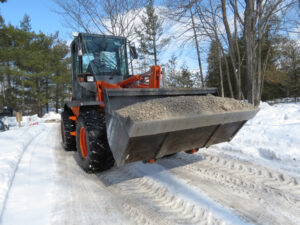 One thing Drost has noticed changing over the years is the accommodations weekenders, vacationers and retirees expect along the Upper West Coast of Michigan.
One thing Drost has noticed changing over the years is the accommodations weekenders, vacationers and retirees expect along the Upper West Coast of Michigan.
They simply demand the best — and Drost Landscape delivers. The company has been recognized eight times by the Michigan Nursery and Landscape Association, winning awards in such categories as residential installation, residential design and installation, residential design/build and residential management.
As a young man growing up in the area, Drost worked on the small farms that then dominated the region. “Landscaping? I didn’t even know what that word meant,” he says. “Seriously, I don’t think many people up here did.” They do now.
“These people come up here to enjoy the lakes and the fresh air, and they will put more money into their homes here than they do downstate,” Drost says. “They trust us, and we don’t take that lightly.”
Drost Landscape has come to rely on good partners to take care of a demanding, high-end customer base in Northern Michigan. Dustin Drost, left, and Robert Drost, center, work with Bill McDaniel of Grand Equipment, the local authorized Hitachi Wheel Loaders dealer.
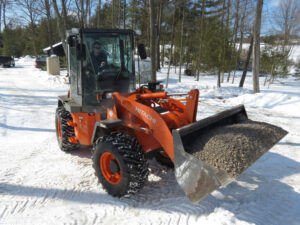 Drost demands the highest standards
Drost demands the highest standards
To deliver the best means being the best and having the best, says the passionate and highly charismatic Drost. The landscaping industry can run the gamut in terms of quality, expertise and performance, but Drost Landscape is a professional organization in the most complete, thorough and strictest definition of the term.
The team grows into the hundreds during peak season, but Drost retains a core full-time staff year-round that includes highly trained and experienced designers, project managers and division managers. Drost credits much of the daily organizational success to Dale Drier, who came aboard in 1997 when the company was about six years old. Now the general manager, Drier is himself a designer who quickly adopted the Drost vision – a mix of traditional service and progressive culture.
“They say no one man does a team make, and that’s really what you see here,” says Drost, known to most people as Bob. “This place is like the hand. You’ve got people who are thumbs, people who are pinkies, people who are index fingers – they all have different attributes. I realized a long time ago it’s not about me; it’s about us. As a team, we can conquer things, and we do. My biggest contribution is a little out-of the-box thinking.”
And, it must be noted, that though he does not operate the equipment, he loves being around it. “I love seeing it, I love learning about it, and I love buying it.” Among the most recent acquisitions is a Hitachi ZW80 compact wheel loader, delivered by Bill McDaniel of Grand Equipment Company, the local authorized Hitachi Wheel Loader dealer, based in Grand Rapids, Michigan.
Hitachi loader earns rave reviews
Replacing a competitive model, the new ZW80 is part of a construction fleet of more than 30 excavators, skid-steer loaders, compact track loaders and wheel loaders. Drost Landscape also owns and operates fleets of trucks, as well as specialized equipment germane to company divisions such as tree service and maintenance
Starting in 1991 with a skid-steer, dump truck and “four guys and myself,” Drost says it’s easy to remain humble. “I remember when we got three pieces of equipment and I thought, there, one for every crew, perfect. And now we run 19 jobs at a time.” It hasn’t taken long for Drost Landscape equipment operators to take note of the 1.2-cubic-yard addition to the loader fleet. “Completely unsolicited, one of the guys said to me just the other day, ‘That new Hitachi is the best loader you’ve got, boss,’” says Drost, whose son Dustin had a similar conversation with the same person. “That operator has grown up around machinery,” says Dustin, a project manager, “and he’s kinda picky, to be honest.”
That operator, Paul Robiadek, works on a crew under supervisor D.J. Hall. Despite it still being the heart of winter, they were busy constructing an outdoor showpiece at a new home near Charlevoix. As well as snow removal, Drost Landscape had about a half-dozen active jobs going in the dead of winter – and that, says Dustin, has been the way for Drost Landscape for the past decade, if not longer
Robiadek raves about the design of the ZW80. He notes the modern exterior sloping and pillarless cab design with floor-to-ceiling glass provide clear visibility all around the machine, “and with a smaller counterweight, you don’t have to worry as much about turning around and hitting something. When you’re in a tight area such as this, you can see all around you and make sure you’re clear.”
At this jobsite, the ZW80 was maximizing its 63 hp of engine output and 8,280 pounds of breakout force to load, move and dump snow, dirt and building materials, as well as to load trucks, which it can still comfortably do at its compact size.
Most impressively, Robiadek swapped out the loader bucket for a fork carriage to move huge rocks to be used in the designed landscape – rocks that average roughly 72 inches by 16 inches by 6 inches apiece and were in some cases being moved two at a time. “All those rocks you see stacked here? I had no problem getting all of them down here from the road, through the trees. The rear tires on that Hitachi loader never came off the ground once,” Robiadek says. “It’s by far one of the best smaller machines I’ve ever operated.” His supervisor and seasoned watcher Hall confirmed the dual rock lifting claim was no exaggeration.
Weighing in at a standard 12,220 pounds, the Hitachi ZW80 is rated to lift and carry loads of up to 3,587 pounds.
A quick loader that is also a quick learn
Dustin Drost, whose brother Travis also works for the company, says the feedback he has received on the ZW80 matches his own experiences. “One thing all the guys have noticed is the power that these loaders have. It’s amazing,” Dustin says. “When you are going a longer distance down the road and are in rabbit mode,
The ZW80 is capable of speeds up to 21.1 mph. “Everyone who operates it is so taken by that,” Dustin says. “And that’s something I noticed right away myself. The first time I operated it, I thought it was moving in rabbit, and I looked down and it was in turtle. Right then and there, I was like, ‘Holy moly.’ Very impressive!”
Aesthetically, the ZW80 is a winner, too. “I like the Hitachi color a lot,” Dustin says. “That Hitachi Orange is really, really nice, because it stands out on site. Yellow often blends in with the sun whereas the orange just pops more.”
On any given day, the nature of the landscaping business is that several different operators may be on a loader, and they find it simple but highly productive,” Dustin says.
Welcome to the family
Robert Drost admits that when McDaniel calls from Grand Equipment, the conversation often goes just about anywhere. Good friends are like that.
The trust that homeowners in and around Petoskey have placed in Drost Landscape is exactly the type of trust he appreciates in the people he does business with. That’s certainly the case with McDaniel and Grand Equipment. “Whatever machine they’re selling, Bill will bring it up just to see if we like it, but it never seems to leave,” Drost says.
It seems that Petoskey’s first Hitachi ZW80 will be keeping busy for some time.
“It’s impressive just how fast this Hitachi loader goes. This one really gets up and goes. Even in turtle mode, it’s quick.”
– Dustin Drost, project manager, Drost Landscaping
This story first appeared in Hitachi’s Q2-2019 issue of FOCUS magazine, also available as a PDF, here on our website.
For more than 30 years, Macedonia, Ohio-based Reliable Snow Plowing Specialists Inc. has served the commercial snow removal market. The company services 450 commercial properties from its headquarters and 50 satellite locations throughout the northern half of the state. In an intensely competitive business, its success is based upon a simple premise: living up to its name.
“What’s important is taking care of customers and getting the results that you promised for each customer,” says Norm Detrick, the company’s president. “It’s all about customer service.”
In addition to their contractual obligations, Detrick says he believes the company has a moral obligation to protect the people walking in and out of customers’ businesses. “There are over a million lives that we impact with each storm,” he adds. “We take it seriously.”
In turn, Reliable Snow Plowing depends on a fleet that can deliver uptime, as well as a dealer who can deliver on its maintenance needs and a manufacturer who ensures a high-quality product and parts availability.
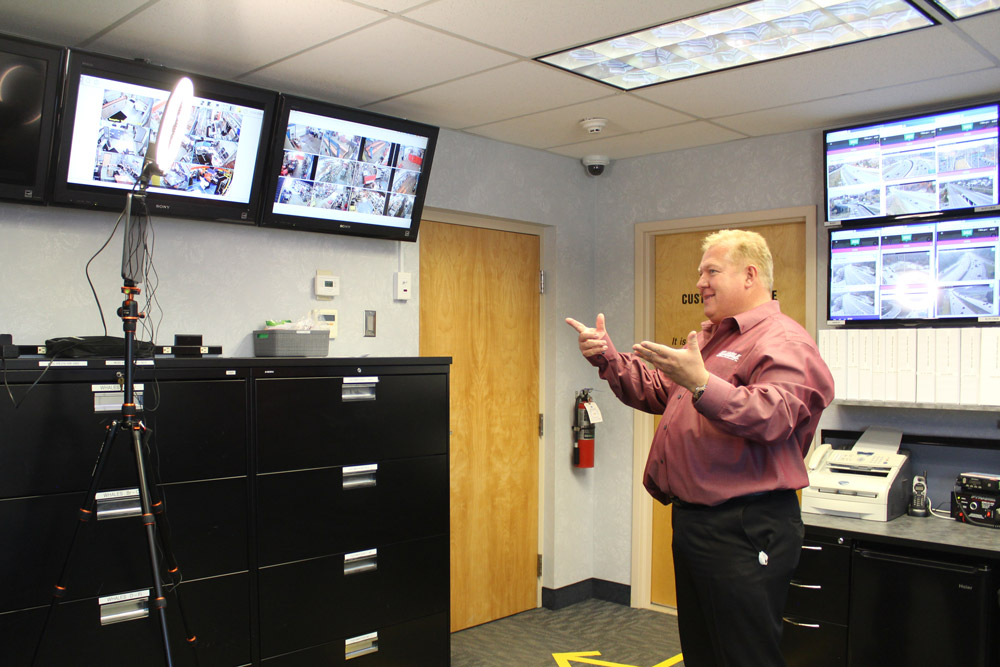
Norm Detrick, president of Reliable Snow Plowing Inc., monitors his fleet of Hitachi ZW80s in his company’s command center.
Building partnerships
To promptly service their 450 commercial customers, Reliable deploys a varied equipment fleet that is evolving through a key partnership with RECO Equipment Inc., its area Hitachi dealer. Over the past several years, Detrick has worked with Dave Ferroni, RECO’s territory sales manager, to determine how Hitachi loaders could best serve the company’s snowplowing needs.
“The partnership started off small and grew as the trust grew,” Detrick says. It began with short-term rentals to meet temporary needs created by large-scale storms. Last winter, Reliable expanded its rental program using more than a dozen loaders in various sizes to plow snow with Hitachi products from late October until early April. As it evaluated the loaders, Reliable also eyed its relationship with RECO and Hitachi to see if it was a good fit.
“Dave circled the wagons and got everyone talking about our unique needs,” Detrick says. Through a series of meetings, Ferroni shared his vision of what the partnership could look like in the future. “Their work culture is remarkable,” Ferroni says. “They all understand that the goal of the company is total customer satisfaction.”
Expanding the fleet
Ultimately, Detrick opted to plow snow with 21 Hitachi ZW80 compact wheel loaders in the first phase of a multiyear, multiphase fleet expansion. Two factors drew him to the model: its dependability and its ability to work in cold temperatures. “It’s a cold-blooded machine; that really appeals to us,” he explains. “We knew this size works really well for us. We call the ZW80 the perfect snow machine!”
The 12,220-pound ZW80 boasts 8,280 pounds of breakout force, with access to extra torque via its manually locking differential — perfect for lifting wet, heavy snow. The center-pin area has robust support structures as well as large pins and bearings. This ensures a steady bucket lift. The fastest machine in its class, the ZW80 can also zip around a jobsite with a top speed of 21.1 mph.
We call the ZW80 the perfect snow machine!.
– Norm Detrick, President, Reliable Snow Plowing Specialists Inc.
Building a matched fleet creates a strategic advantage for the business for several reasons, Detrick says. Most importantly, equipment operators can get into any one of the loaders and get straight to work. In a market where the operator hops into the cab at 2 or 3 a.m., intuitive operations are particularly important for optimizing safety. The fully enclosed cab is sound insulated to provide a quiet, distraction-free environment, and floor-to-ceiling tinted glass windows – with a pillarless design – provide the clear lines of sight needed for plowing during snow squalls.
Expanding the fleet with ZW80s also streamlines maintenance. “The learning curve that goes into supporting and maintaining a fleet is drawn down when you’re dealing with a matched fleet,” Detrick adds. From a serviceability perspective, it also minimizes stocking requirements. He and Ferroni methodically reviewed which components should be kept in stock. Both Reliable Snow Plowing and RECO stock a backup unit while RECO maintains inventory of necessary maintenance items to ensure that Reliable can always meet its customers’ needs.
“We went through this and took a real-world approach,” Detrick says. “Hitachi loaders delivered a turnkey solution and have supported it with multiple branches and multiple mechanics in the field. That was a strategic advantage they brought to the field.”
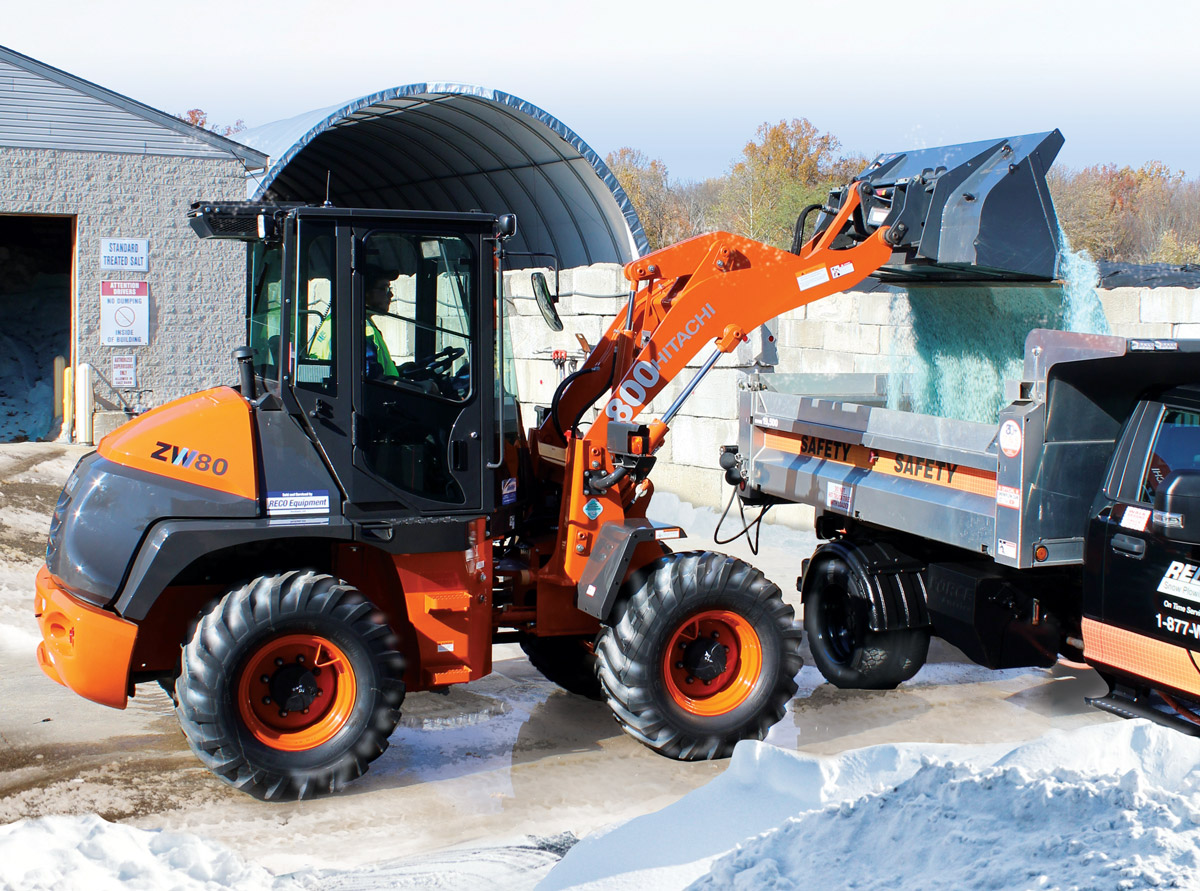 Mixing high- and low-tech strategies
Mixing high- and low-tech strategies
Meeting customer needs demands strong communication among Reliable Snow Plowing’s multiple locations and staff. That communication includes a mix of high-tech and low-tech strategies modeled after first responders such as police and fire departments. For example, most communication between snow fighters is via two-way radios and pagers. “People laugh at us, but you know what? The doggone things work,” Detrick says. In fact, pagers allow him to contact one employee or 800 within seconds. He appreciates that efficiency.
From a high-tech perspective, snowplows are equipped with plow cams that allow the business to track weather conditions in real time. At the company’s command center, a grid-like display showcases the view from 150 cameras placed across Reliable Snow Plowing’s entire market. This helps the company track lake effect storms — which can change at a moment’s notice — as they move through the area. “It gives you a situational awareness of how a storm is coming in and what the conditions are on pavement,” Detrick says, explaining that no two lake effect storms are the same.
This storm tracking ability is so valuable that it led to an innovative partnership between Reliable Snow Plowing and Channel 19, northeast Ohio’s CBS affiliate. Through that alliance, the television station has access to more than two dozen of Reliable’s snowplow cameras. “It gives them a tremendous amount of shot diversity and a different way to tell the weather story,” Detrick explains. “The flip side is they give us an open door to their meteorologist.”
When a storm front moves into the area, it’s not unusual for Detrick to talk to the meteorologist throughout the event and get up-to-the-minute pinpoint forecasts. These forecasts help the company provide the best possible service to its customers by allowing it to move plow trucks and sidewalk shovelers to the areas of its market that most need them during each storm.
Planning for the future
Through strategic partnerships and savvy business practices, Reliable Snow Plowing enjoys its reputation as the premiere service provider in its market and intends to stay on top. The second and third phases of fleet expansion will each add another 21 ZW80s to the fleet over the coming years.
“This product is very, very dependable,” Detrick says. “It’s not only a high-quality product that works well, but also at a price point that is favorable. Plowing snow with Hitachi makes a lot of sense.”
“Going forward, we have the solutions to build this into something great,” Ferroni adds. “It’s a win-win partnership for Reliable Snow Plowing, RECO Equipment and Hitachi wheel loaders.”
Hitachi’s entry into the compact wheel loader market started back in 2010 when a joint venture was formed between Kawasaki Heavy Industries and Hitachi Construction Machinery to further develop the global scope of the Kawasaki brand wheel loaders. After a few more business deals and a name change, Hitachi Construction Machinery Loaders America Inc released its own brand of wheel loaders in 2018.
“Our legacy models, the Kawasaki compact loaders, came to the North American market in 1985,” says Sam Shelton, marketing manager for Hitachi. “As Hitachi, we have introduced the ZW30-5b, ZW50-5b, ZW80-5b, and ZW120-6 to the market. All of the models are DPF free and have been well received.”
To read the full article featuring Hitachi’s ZW Compact Loaders in the January 2020 issue of Compact Equipment Magazine, click here.
Or check out the full January 2020 issue, featuring the ZW80-5b on the cover, here.
Compact Equipment Magazine announced its winners for the most outstanding equipment released over the last 12 months- and the ZW50 and ZW80 both made the top of the list!
Simple. The complexity of high tech is not something everyone wants or needs. From the onset, simplicity was the mantra defining the ZW50 and ZW80 compact wheel loaders. Both are equipped with simple mechanical controls and a simple electrical system with no complex, inter-related, dependent systems. They are simple to service machines with engine oil changes extended to 500 hours. Ther’s no DPF to plug, regenerate, maintain, or replace. No SCR or DEF to purchase or fill. There’s a mechanical control lever for intuitive lift and dump functions and a smooth hydrostatic powertrain with rimpull performance and dynamic braking and inching. We could go on, but there’s only so much room.
Click here to read the feature announcing the 2019 Innovative Iron Award win for the ZW50 and ZW80.
CROWD PLEASERS: These Compact Wheel Loaders Are Some of the Most Popular on the Market
Why do certain models of compact wheel loaders outsell others in a manufacturer’s lineup or in the overall market? The answer ranges from models offering market-leading performance to buyers changing direction in their preferences. It’s a sort of dance with compact wheel loaders and buyers taking turns leading.
To read the full article in Compact Equipment featuring interviews with HCMA representatives, click here.
The owners of the “Up North” homes of “Pure Michigan” simply demand the best- and Drost Landscape delivers. Established in 1991 in Petosky, Michigan, the company has been recognized eight times by the Michigan Nursery and Landscape Association. To secure its continued success, Drost Landscape recently acquired Hitachi’s ZW80 compact wheel loader and races about the design and capability. Click to read the article in the June 2019 Compact Equipment magazine.
You’re busy. We get it. You don’t have time to read a 2,000-word article on the small wheel loader market. You’ve maybe already decided that it’s not really the machine for you. It’s too expensive. It looks a little too big to easily trailer. Plus, you’re heavily vested in your skid steer attachments. Double plus, the rental lots never seem to have them, so you never get to operate those units. We get that, but just hear us out. compact wheel loaders have many advantages over competitive machine categories: better fuel economy, less tire wear, increased visibility, and beyond. We’ll make this easy on you by quickly breaking down the American market for compact wheel loaders into short, easy-to-digest paragraphs.
To read the article featuring the ZW50 and ZW80 in Compact Equipment Magazine (February 2019), click here.
